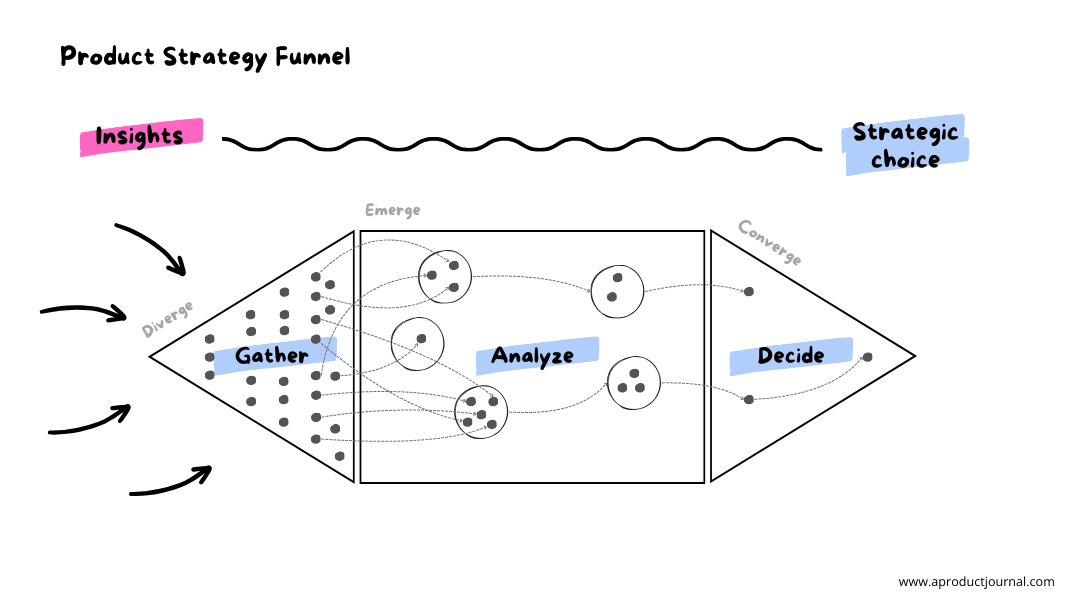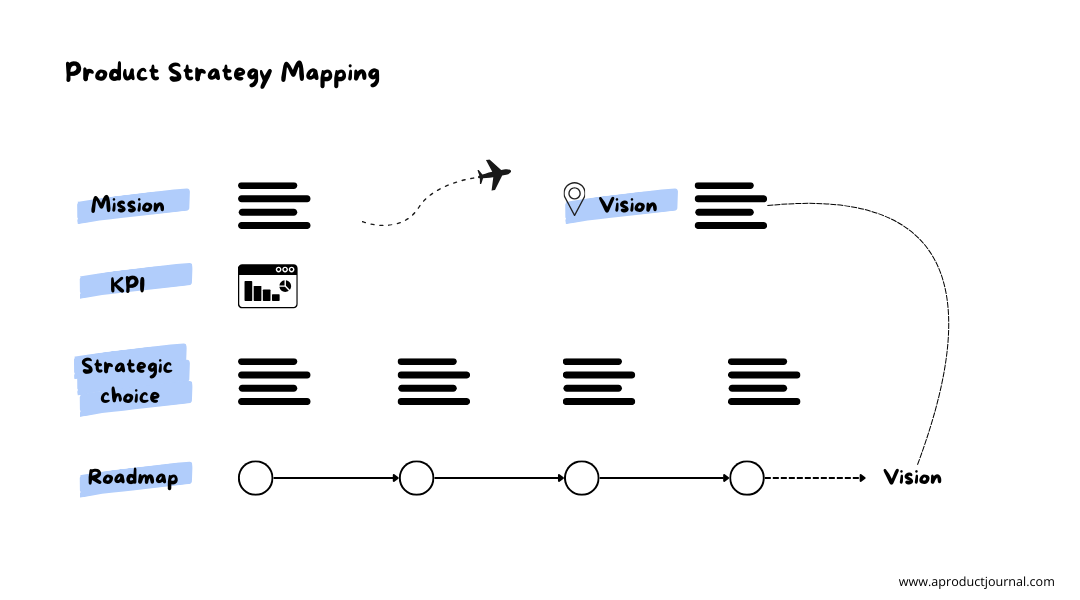♟️ Product Strategy
Define the right direction
Table of Contents

By Tolgay B.
Sometimes, explaining the importance of a clear and effective product strategy feels like convincing my kid that vegetables are exciting 🥦. It’s necessary, yet tricky! A solid product strategy isn’t just part of the game; it’s the playbook that prevents us from wandering aimlessly, hoping our product will miraculously find its way to success. Is it something concrete? Is it tangible?
On this page, I’ll explore what Product Strategy means, outline a practical approach to developing one, and discuss both its benefits and challenges. Additionally, I’ll recommend some effective tools that support and enhance the strategic process. My goal is to share with you, things that worked for me.
Definition
I believe it’s fair to say that product strategy is the backbone of a product’s lifecycle. It details how we envision the product to make a positive impact in the world. We can think of it as the master plan that influences most crucial moves and decision we make, ensuring that all efforts align perfectly. It not only maps out where we want to go and how we’ll get there but also clarifies why we opt for certain approaches over others, paving the way for success through smart, well-thought-out decisions.
Strategy Funnel
Where does the reflection on product strategy start, and where does it end? One natural and effective approach is to envision it as funnel model, structuring the reflection through three key phases: Gather, Define, and Decide.
Gather (Diverge): In this phase, we gather as much information as possible from various sources, both internal and external. This approach broadens our contextual understanding and enriches our product strategy with comprehensive insights.
Analyze (Emerge): This phase involves analyzing the collected information, interpreting data, and deriving meaningful insights that guide strategic decisions. We also get to reassess our long-term vision and mission, making adjustments that align with our ultimate goals and current situation.
Decide (Converge): In this final phase, we establish commitments based on thorough analysis. Here, the output (as I like to use it) is a strategic choice, encapsulating the “why” and the expected outcome. This choice sets a definitive direction and specific objectives that align with our product’s vision and mission.

Output: Strategic Choice Template
This output template provides a clear and structured way to document strategic choices. Here’s a breakdown of each component of the template and why it’s important:
Title: Assign a clear and concise title that encapsulates the essence of the strategic decision, facilitating quick identification and reference.
Context: Provide the necessary background that initiated the strategic decision, including data from internal sources and market analysis. Highlight key insights that directly influenced the strategy, ensuring all decisions are grounded in substantial evidence.
Why now: This section clarifies the importance of implementing the strategy at this moment. It highlights how acting now can leverage current market opportunities, respond to competitive dynamics, and mitigate emerging risks. Delaying action could lead to missed advantages and increased vulnerabilities, underscoring the necessity of immediate execution to maximize strategic outcomes.
Fit with vision and mission: Demonstrate how the strategy aligns with the organization’s broader vision and mission, ensuring that the strategic choice contributes cohesively to long-term goals.
Expected outcomes (with OKRs): Clearly articulate the objectives of the strategy and define measurable key results to track its effectiveness. This establishes clear targets and accountability.
Benefits
Aligned team effort and focus: A well-defined product strategy ensures that everyone in your team understands the direction and priorities. This alignment helps to avoid distractions, keeps everyone working towards the same goals, and ensures that resources are allocated efficiently.
Improved decision making: With a clear strategy in place, decisions can be made more confidently and quickly. It serves as a guiding framework that helps prioritize initiatives, validate ideas, and make trade-offs, ultimately leading to more consistent and strategic choices.
Drives long-term success and growth: A robust product strategy provides a clear roadmap for achieving long-term goals, helping to drive sustainable growth. It enables you to anticipate market changes, adapt to new opportunities, and stay ahead of competitors by consistently delivering value to customers.
Common Pitfalls
Lack of clear vision and mission: Without a clearly articulated vision and mission, a product strategy can become aimless, leading to confusion among team members and misaligned efforts. This ambiguity complicates strategic decision-making and can undermine the coherence of development initiatives. Ensure your strategy is firmly rooted in a compelling vision and mission that guide all actions and decisions.
Overly rigid planning: While having a strategy is crucial, being too rigid can hinder adaptability. Markets, customer needs, and competitive landscapes can change rapidly. An inflexible strategy can prevent your team from pivoting or seizing new opportunities. Build flexibility into your strategy, allowing for adjustments when necessary to stay relevant and competitive.
Ignoring market and user feedback: A product strategy that is developed in isolation, without considering market trends or user feedback, risks missing the mark. Failing to integrate real-world insights can result in a product that does not meet user needs or fails to stand out in the market. Continuously validate your strategy with data, market research, and user feedback.
Mapping
All the theory discussed is well and good, but how do we actually establish an effective product strategy? There are numerous approaches to developing product strategies, and there’s likely no absolute right or wrong way, as long as the strategy effectively guides the team and bridges the gap between a long-term vision and immediate actions.
To achieve this, I like to use a set of tools that work seamlessly together, each enhancing the overall coherence and strategic alignment of our efforts. These tools not only help in shaping our strategy but also ensure it remains relevant and actionable. Here is the mapping:

Example
Use Case: Setting up the HostSpot Strategy for Q1
🔮 Vision and Mission
- Vision: (Our vision is to) create a world where travel is not just a journey but a transformative experience.
- Mission: (Our mission is to) offer a global platform that goes beyond accommodations, fostering a sense of belonging for travelers worldwide.
📊 Key Performance Indicators (KPIs)
- User Engagement Rate: Percentage of users actively interacting with premium listings, experiences, or community features; target 40% engagement rate.
- Booking Conversion Rate: Percentage of users who complete a booking after visiting the platform; target 15% conversion rate.
- Sustainable Bookings Growth: Track the year-over-year increase in bookings of eco-friendly listings, targeting a 30% growth rate.
- Experience Utilization Rate: Measure the percentage of users who book an experience along with accommodation; target 25% utilization.
🎯 Strategic Choice
Title
Expanding Platform Offerings to Include Local Experiences
Context
Recent market research has indicated a growing trend in consumers seeking immersive local experiences as part of their travel itinerary. Internal data show that guests are increasingly looking for unique, culturally enriching activities close to their accommodation locations. This strategic choice is motivated by the desire to tap into this lucrative market segment and enhance overall guest satisfaction by offering a more comprehensive travel experience.
Why Now
The travel industry is rapidly evolving, with competitors already beginning to capitalize on the trend of experiential travel. Acting now allows us to establish a market presence in this emerging sector, secure partnerships with local businesses, and integrate these offerings seamlessly with our existing services. Delaying could result in losing market share to competitors and missing the peak interest phase among our target demographic.
Fit with Vision and Mission
This strategic choice aligns perfectly with our mission to provide comprehensive, unforgettable travel experiences and our vision to be the go-to platform for all travel needs. By expanding our offerings to include local experiences, we are moving closer to becoming a full-service travel provider, which enhances our value proposition and supports long-term business growth.
Expected Outcomes (with OKRs)
🏔️ Objective: Diversify platform offerings to include local experiences.
🚩 Key Result #1: Successfully curate and launch 100 unique local experiences.
🚩 Key Result #2: Achieve a booking rate of 25% for these experiences among guests who book accommodations.
Disclaimer: This is a fictional example created for illustrative purposes only. It aims to demonstrate how product strategy concepts can be applied in a practical scenario.
Conclusion
In conclusion, crafting a product strategy isn’t just about adhering to rigid rules, tools, or frameworks. There’s no magic formula, at least not one that I’m aware of. It’s all about setting the right direction so that every immediate action aligns with the long-term vision. By integrating tools and frameworks that fit your specific context into overarching goals, you ensure that every team member is not only aware of the destination but also well-equipped for the journey. Remember, a well-defined product strategy acts like a compass, guiding your product throughout its lifecycle and ensuring that each step forward is a step toward success.
Strategy Tools
🔮 Vision and Mission
A clear vision inspires the team, while a mission aligns all efforts towards shared goals.
📊 Key Performance Indicators (KPI)
KPIs measure product success, offering insights that guide data-driven decisions.
🚩 Objective Key Results (OKR)
OKRs set and track goals, aligning efforts and ensuring transparency with measurable outcomes.
COMING SOON